Solar eclipse of July 20, 1963
A total solar eclipse occurred on Saturday, July 20, 1963. A solar eclipse occurs when the Moon passes between Earth and the Sun, thereby totally or partly obscuring the image of the Sun for a viewer on Earth. A total solar eclipse occurs when the Moon's apparent diameter is the same size as the Sun's, blocking all direct sunlight, turning day into darkness. Totality occurs in a narrow path across Earth's surface, with the partial solar eclipse visible over a surrounding region thousands of kilometres wide. Totality was visible from Hokkaido in Japan and Kuril Islands in Soviet Union (now belonging to Russia) on July 21, and Alaska, and Maine in the United States and also Canada on July 20. Astronomer Charles H. Smiley observed the eclipse from a U.S. Air Force F-104D Starfighter supersonic aircraft that was "racing the moon's shadow" at 1,300 mph (2,100 km/h) extending the duration of totality to 4 minutes 3 seconds.[1] The moon was 375,819 km (233,523 mi) from the Earth.
| Solar eclipse of July 20, 1963 | |
|---|---|
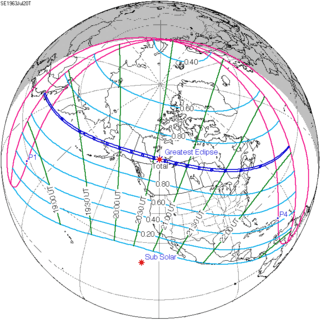 Map | |
| Type of eclipse | |
| Nature | Total |
| Gamma | 0.6571 |
| Magnitude | 1.0224 |
| Maximum eclipse | |
| Duration | 100 sec (1 m 40 s) |
| Coordinates | 61.7°N 119.6°W |
| Max. width of band | 101 km (63 mi) |
| Times (UTC) | |
| Greatest eclipse | 20:36:13 |
| References | |
| Saros | 145 (19 of 77) |
| Catalog # (SE5000) | 9427 |
Occurring about 4.1 days after perigee (Perigee on July 16, 1963), the Moon’s apparent diameter was larger.
The moon's apparent diameter was 4.8 arcseconds smaller than the January 25, 1963 annular solar eclipse. This was a total solar eclipse because occurred in July and July is near is aphelion (furthest apart to the Sun). The moon's apparent diameter was just over 2.2% larger than the Sun's.
In popular culture
The eclipse was featured in the comic strip Peanuts (July 15–20, 1963), with Linus demonstrating a safe way of observing the eclipse as opposed to looking directly at the eclipse. On the day the eclipse passed over his area, Linus was left helplessly standing in the rain with cloud cover entirely too thick to witness the eclipse.
This particular eclipse event plays an important part in two of Stephen King's novels, Gerald's Game (1992) and Dolores Claiborne (1992). It was also featured in a season 3 episode of Mad Men titled "Seven Twenty Three" (2009).[2]
Related eclipses
Sar (Half-Saros), Lunar Saros 138
- Preceded: Lunar eclipse of July 16, 1954
- Followed: Lunar eclipse of July 26, 1972
Solar eclipses of 1961–1964
This eclipse is a member of a semester series. An eclipse in a semester series of solar eclipses repeats approximately every 177 days and 4 hours (a semester) at alternating nodes of the Moon's orbit.[3]
| Solar eclipse series sets from 1961–1964 | ||||||
|---|---|---|---|---|---|---|
| Descending node | Ascending node | |||||
| Saros | Map | Saros | Map | |||
| 120 |  1961 February 15 Total |
125 |  1961 August 11 Annular | |||
| 130 |  1962 February 5 Total |
135 |  1962 July 31 Annular | |||
| 140 | 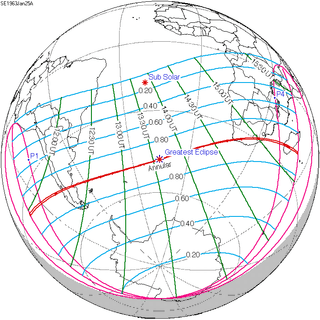 1963 January 25 Annular |
145 |  1963 July 20 Total | |||
| 150 | 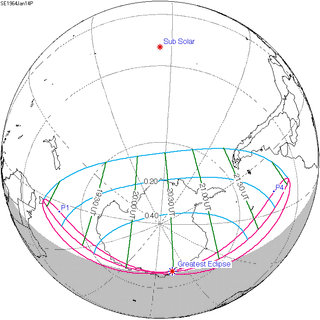 1964 January 14 Partial |
155 | 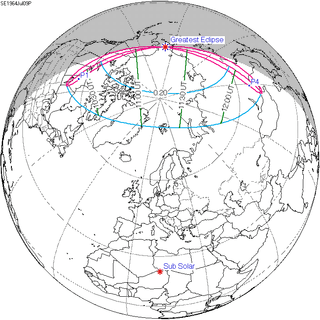 1964 July 9 Partial | |||
| Partial solar eclipses of June 10, 1964 and December 4, 1964 belong in the next lunar year set. | ||||||
Saros 145
This solar eclipse is a part of Saros cycle 145, repeating every 18 years, 11 days, 8 hours, containing 77 events. The series started with a partial solar eclipse on January 4, 1639, and reached a first annular eclipse on June 6, 1891. It was a hybrid event on June 17, 1909, and total eclipses from June 29, 1927, through September 9, 2648. The series ends at member 77 as a partial eclipse on April 17, 3009. The longest eclipse will occur on June 25, 2522, with a maximum duration of totality of 7 minutes, 12 seconds. All eclipses in this series occurs at the Moon’s ascending node.
| Series members 10–32 occur between 1801 and 2359 | ||
|---|---|---|
| 10 | 11 | 12 |
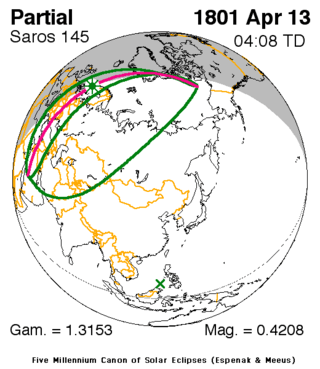 April 13, 1801 |
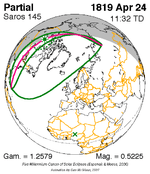 April 24, 1819 |
 May 4, 1837 |
| 13 | 14 | 15 |
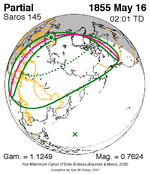 May 16, 1855 |
 May 26, 1873 |
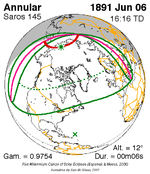 June 6, 1891 |
| 16 | 17 | 18 |
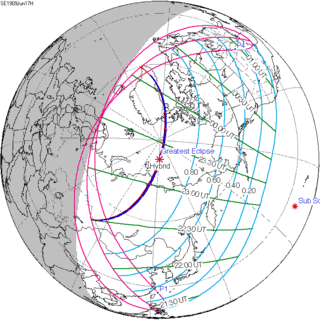 June 17, 1909 |
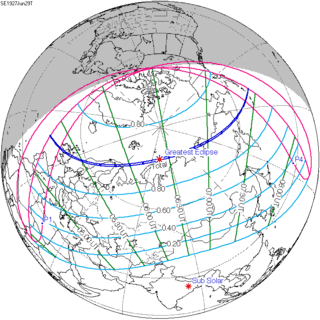 June 29, 1927 |
 July 9, 1945 |
| 19 | 20 | 21 |
 July 20, 1963 |
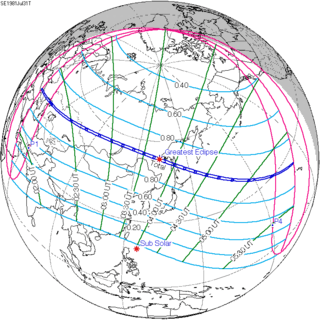 July 31, 1981 |
 August 11, 1999 |
| 22 | 23 | 24 |
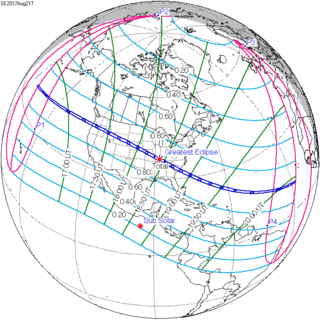 August 21, 2017 |
 September 2, 2035 |
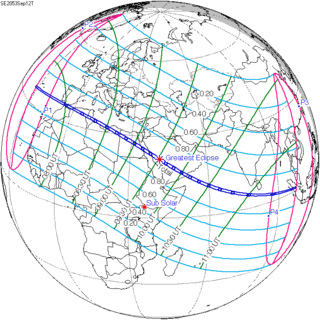 September 12, 2053 |
| 25 | 26 | 27 |
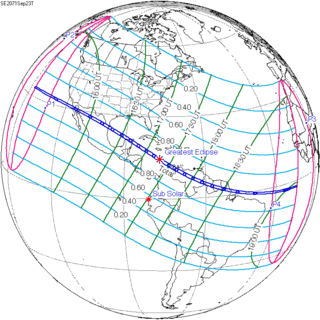 September 23, 2071 |
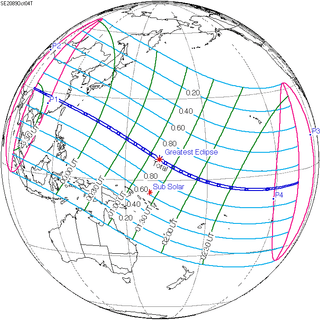 October 4, 2089 |
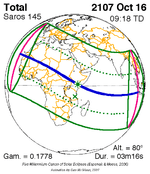 October 16, 2107 |
| 28 | 29 | 30 |
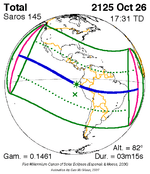 October 26, 2125 |
 November 7, 2143 |
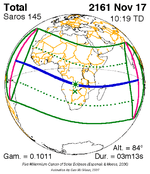 November 17, 2161 |
| 31 | 32 | 33 |
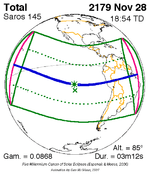 November 28, 2179 |
 December 9, 2197 |
 December 21, 2215 |
| 34 | 35 | 36 |
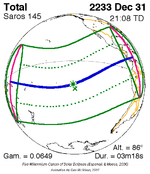 December 31, 2233 |
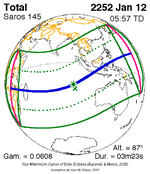 January 12, 2252 |
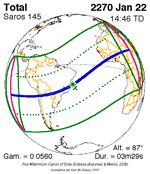 January 22, 2270 |
| 37 | 38 | 39 |
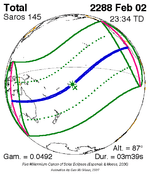 February 2, 2288 |
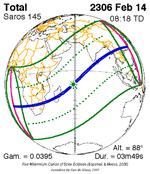 February 14, 2306 |
 February 25, 2324 |
| 40 | ||
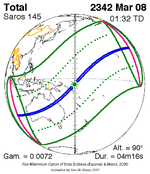 March 8, 2342 | ||
Inex series
This eclipse is a part of the long period inex cycle, repeating at alternating nodes, every 358 synodic months (≈ 10,571.95 days, or 29 years minus 20 days). Their appearance and longitude are irregular due to a lack of synchronization with the anomalistic month (period of perigee). However, groupings of 3 inex cycles (≈ 87 years minus 2 months) comes close (≈ 1,151.02 anomalistic months), so eclipses are similar in these groupings. In the 19th century:
• Solar Saros 140: Total Solar Eclipse of 1818 Oct 29
• Solar Saros 141: Annular Solar Eclipse of 1847 Oct 09
• Solar Saros 142: Total Solar Eclipse of 1876 Sep 17
| Inex series members between 1901 and 2100: | ||
|---|---|---|
 August 30, 1905 (Saros 143) |
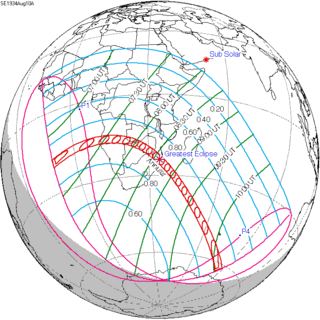 August 10, 1934 (Saros 144) |
 July 20, 1963 (Saros 145) |
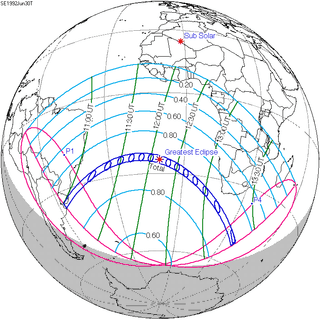 June 30, 1992 (Saros 146) |
 June 10, 2021 (Saros 147) |
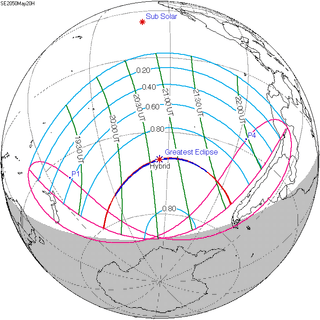 May 20, 2050 (Saros 148) |
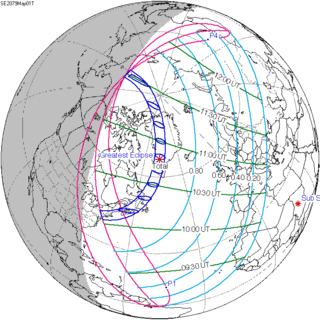 May 1, 2079 (Saros 149) |
||
In the 22nd century:
Solar Saros 150: Partial Solar Eclipse of 2108 Apr 11
Solar Saros 151: Annular Solar Eclipse of 2137 Mar 21
Solar Saros 152: Total Solar Eclipse of 2166 Mar 02
Solar Saros 153: Annular Solar Eclipse of 2195 Feb 10
Metonic series
The metonic series repeats eclipses every 19 years (6939.69 days), lasting about 5 cycles. Eclipses occur in nearly the same calendar date. In addition, the octon subseries repeats 1/5 of that or every 3.8 years (1387.94 days).
| 21 eclipse events between July 21, 1906 and July 20, 1982 | ||||
|---|---|---|---|---|
| July 20–21 | May 9 | February 24–25 | December 13–14 | October 1–2 |
| 105 | 107 | 109 | 111 | 113 |
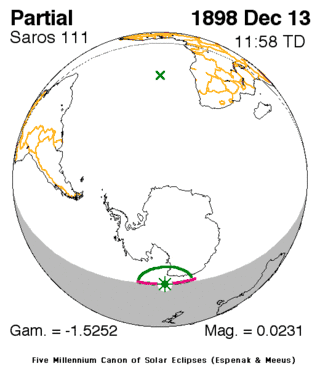 December 13, 1898 |
||||
| 115 | 117 | 119 | 121 | 123 |
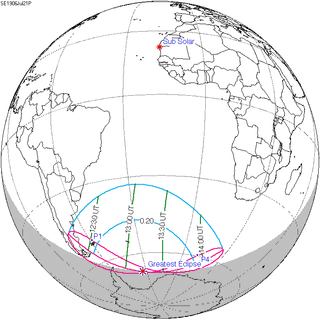 July 21, 1906 |
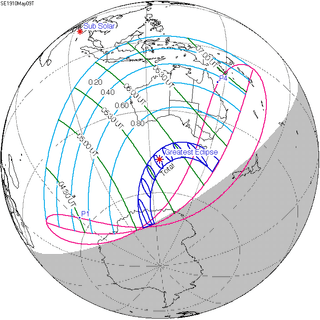 May 9, 1910 |
 February 25, 1914 |
 December 14, 1917 |
 October 1, 1921 |
| 125 | 127 | 129 | 131 | 133 |
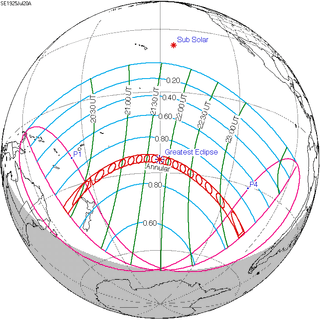 July 20, 1925 |
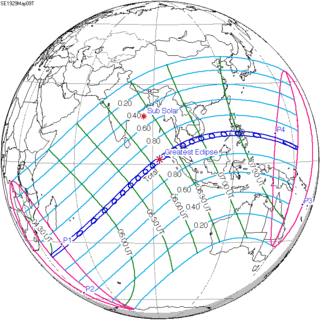 May 9, 1929 |
 February 24, 1933 |
 December 13, 1936 |
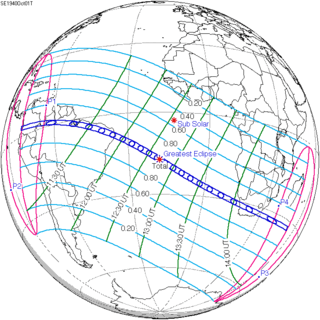 October 1, 1940 |
| 135 | 137 | 139 | 141 | 143 |
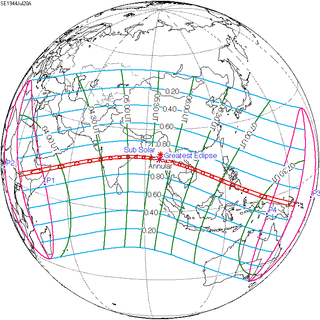 July 20, 1944 |
 May 9, 1948 |
 February 25, 1952 |
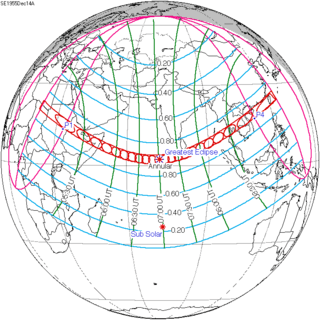 December 14, 1955 |
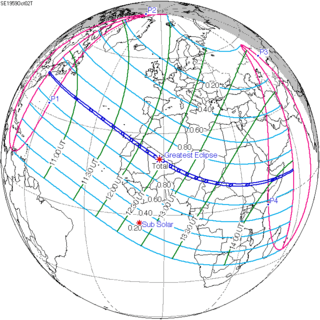 October 2, 1959 |
| 145 | 147 | 149 | 151 | 153 |
 July 20, 1963 |
 May 9, 1967 |
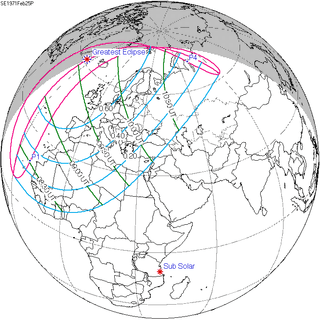 February 25, 1971 |
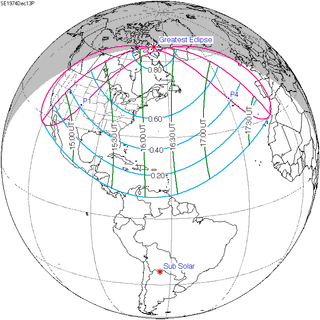 December 13, 1974 |
 October 2, 1978 |
| 155 | ||||
 July 20, 1982 | ||||
Notes
- Smiley, Charles H. (February 1964). "Racing the Moon's Shadow on July 20, 1963". Journal of the Royal Astronomical Society of Canada. 58 (1): 10–12. Bibcode:1964JRASC..58...10S.
The United States Air Force provided an F-104D, a Starfighter made by Lockheed, and Major William A. Cato piloted the plane from Kirkland Air Force Base in New Mexico to Uplands Airport, Ottawa. Since the duration of totality depends on the difference between the speed of the plane and the speed of the moon's shadow, we elected to fly north-west to meet the shadow, then turn and increase speed so that we would reach our maximum speed at 42,000 feet as the shadow overtook us and continue to climb, attaining 48,000 feet as the shadow left us.
- Episode 7: Seven Twenty Three (Details tab) http://www.amctv.com/shows/mad-men/episodes/season-3/seven-twenty-three
- van Gent, R.H. "Solar- and Lunar-Eclipse Predictions from Antiquity to the Present". A Catalogue of Eclipse Cycles. Utrecht University. Retrieved 6 October 2018.
References
- Earth visibility chart and eclipse statistics Eclipse Predictions by Fred Espenak, NASA/GSFC
| Wikimedia Commons has media related to Solar eclipse of 1963 July 20. |
.jpg)
